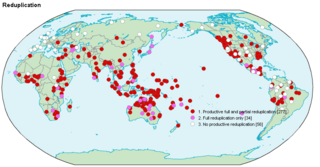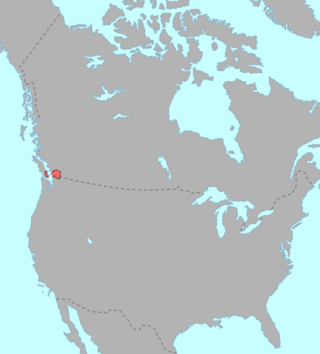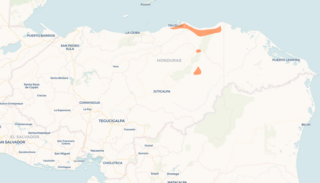Related Research Articles

In linguistics, reduplication is a morphological process in which the root or stem of a word or even the whole word is repeated exactly or with a slight change.

Hadza is a language isolate spoken along the shores of Lake Eyasi in Tanzania by around 1,000 Hadza people, who include in their number the last full-time hunter-gatherers in Africa. It is one of only three languages in East Africa with click consonants. Despite the small number of speakers, language use is vigorous, with most children learning it, but UNESCO categorizes the language as vulnerable.

Crow is a Missouri Valley Siouan language spoken primarily by the Crow Nation in present-day southeastern Montana. The word Apsáalooke translates to "Children of the Large Beaked Bird", which was later incorrectly translated into English as 'Crow'. It is one of the larger populations of American Indian languages with 4,160 speakers according to the 2015 US Census.

Masbateño or Minasbate is a member of Central Philippine languages and of the Bisayan subgroup of the Austronesian language family spoken by more than 724,000 people in the province of Masbate and some parts of Sorsogon in the Philippines. Masbatenyo is the name used by the speakers of the language and for themselves, although the term Minásbate is sometimes also used to distinguish the language from the people. It has 350,000 speakers as of 2002, with 50,000 who speak it as their first language. About 250,000 speakers use it as their second language.

Halkomelem is a language of various First Nations peoples of the British Columbia Coast. It is spoken in what is now British Columbia, ranging from southeastern Vancouver Island from the west shore of Saanich Inlet northward beyond Gabriola Island and Nanaimo to Nanoose Bay and including the Lower Mainland from the Fraser River Delta upriver to Harrison Lake and the lower boundary of the Fraser Canyon.

Klallam,Clallam, Ns'Klallam or S'klallam, is a Straits Salishan language historically spoken by the Klallam people at Becher Bay on Vancouver Island in British Columbia and across the Strait of Juan de Fuca on the north coast of the Olympic Peninsula in Washington. The last native speaker of Klallam as a first language died in 2014, but there is a growing group of speakers of Klallam as a second language.
Kapingamarangi is a Polynesian language spoken in the Federated States of Micronesia. It had 3,000 native speakers in 1995. The language is closely related to the Nukuoro language.

The Wariʼ language is the sole remaining vibrant language of the Chapacuran language family of the Brazilian–Bolivian border region of the Amazon. It has about 2,700 speakers, also called Wariʼ, who live along tributaries of the Pacaas Novos river in Western Brazil. The word wariʼ means "we!" in the Wariʼ language and is the term given to the language and tribe by its speakers.
Tsimshian, known by its speakers as Sm'álgyax, is a dialect of the Tsimshian language spoken in northwestern British Columbia and southeastern Alaska. Sm'algyax means literally "real or true language."
Proto-Indo-European nominals include nouns, adjectives, and pronouns. Their grammatical forms and meanings have been reconstructed by modern linguists, based on similarities found across all Indo-European languages. This article discusses nouns and adjectives; Proto-Indo-European pronouns are treated elsewhere.
Pohnpeian is a Micronesian language spoken as the indigenous language of the island of Pohnpei in the Caroline Islands. Pohnpeian has approximately 30,000 (estimated) native speakers living in Pohnpei and its outlying atolls and islands with another 10,000-15,000 (estimated) living off island in parts of the US mainland, Hawaii and Guam. It is the second-most widely spoken native language of the Federated States of Micronesia the first being Chuukese.

Tiipai (Tipay) is a Native American language belonging to the Delta–California branch of the Yuman language family, which spans Arizona, California, and Baja California. As part of the Yuman family, Tiipai has also been consistently included in the controversial quasi-stock Hokan. Tiipai is spoken by a number of Kumeyaay tribes in northern Baja California and southern San Diego County, California. There were, conservatively, 200 Tiipai speakers in the early 1990s; the number of speakers has since declined steadily, numbering roughly 100 speakers in Baja California in a 2007 survey.

Aguaruna is an indigenous American language of the Chicham family spoken by the Aguaruna people in Northern Peru. According to Ethnologue, based on the 2007 Census, 53,400 people out of the 55,700 ethnic group speak Aguaruna, making up almost the entire population. It is used vigorously in all domains of life, both written and oral. It is written with the Latin script. The literacy rate in Aguaruna is 60-90%. However, there are few monolingual speakers today; nearly all speakers also speak Spanish. The school system begins with Aguaruna, and as the students progress, Spanish is gradually added. There is a positive outlook and connotation in regard to bilingualism. 50 to 75% of the Aguaruna population are literate in Spanish. A modest dictionary of the language has been published.
Southern Oromo, or Borana, is a variety of Oromo spoken in southern Ethiopia and northern Kenya by the Borana people. Günther Schlee also notes that it is the native language of a number of related peoples, such as the Sakuye.

Lardil, also spelled Leerdil or Leertil, is a moribund language spoken by the Lardil people on Mornington Island (Kunhanha), in the Wellesley Islands of Queensland in northern Australia. Lardil is unusual among Aboriginal Australian languages in that it features a ceremonial register, called Damin. Damin is regarded by Lardil-speakers as a separate language and has the only phonological system outside Africa to use click consonants.
Baiso or Bayso is an Afro-Asiatic, more specifically a Lowland East Cushitic language belonging to the Omo-Tana subgroup, and is spoken in Ethiopia, in the region around Lake Abaya.

Pech or Pesh is a Chibchan language spoken in Honduras. It was formerly known as Paya, and continues to be referred to in this manner by several sources, though there are negative connotations associated with this term. It has also been referred to as Seco. There are 300 speakers according to Yasugi (2007). It is spoken near the north-central coast of Honduras, in the Dulce Nombre de Culmí municipality of Olancho Department.
Vamale (Pamale) is a Kanak language of northern New Caledonia. The Hmwaeke dialect, spoken in Tiéta, is fusing with Haveke and nearly extinct. Vamale is nowadays spoken in Tiendanite, We Hava, Téganpaïk and Tiouandé. It was spoken in the Pamale valley and its tributaries Vawe and Usa until the colonial war of 1917, when its speakers were displaced.
Pendau, or Umalasa, is a Celebic language of Sulawesi in Indonesia spoken by the approximately 4000 Pendau people who live in Central Sulawesi. Classified as an endangered language, Pendau is primarily spoken inside of Pendau villages whereas Indonesian is used to speak with neighboring communities and is the language of children's education and outside officials. The highest concentration of speakers is in and around Kecamatan Balaesang. There are no known dialects within the Pendau region, although speakers from the mainland can identify whether a speaker is from the Balaesang peninsula through their 'rhythm' or intonation pattern. In recent years, some Pendau leaders have worked with local government to preserve their language alongside Indonesian.

Proto-Slavic is the unattested, reconstructed proto-language of all Slavic languages. It represents Slavic speech approximately from the 2nd millennium BC through the 6th century AD. As with most other proto-languages, no attested writings have been found; scholars have reconstructed the language by applying the comparative method to all the attested Slavic languages and by taking into account other Indo-European languages.
References
- Exter, Mats, (2003) Phonetik und Phonologie des Wogeo. Arbeitspapier (Universität zu Köln. Institut für Sprachwissenschaft) ; Nr. 46